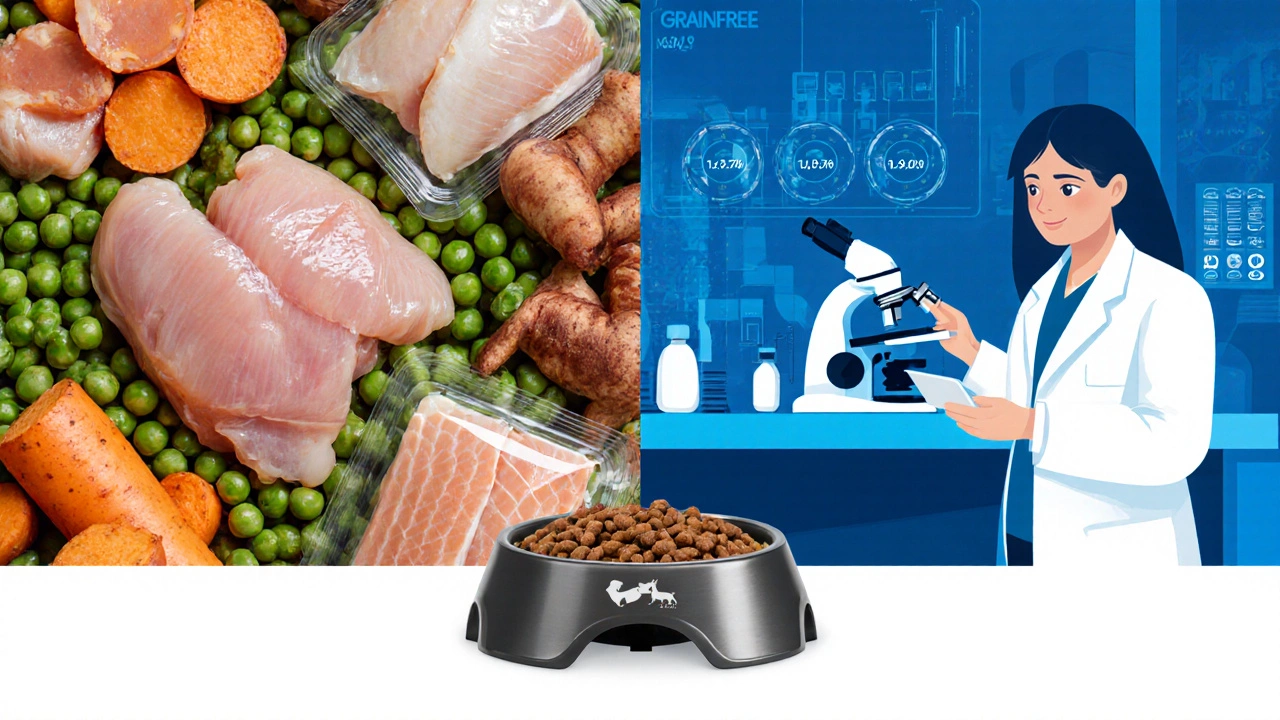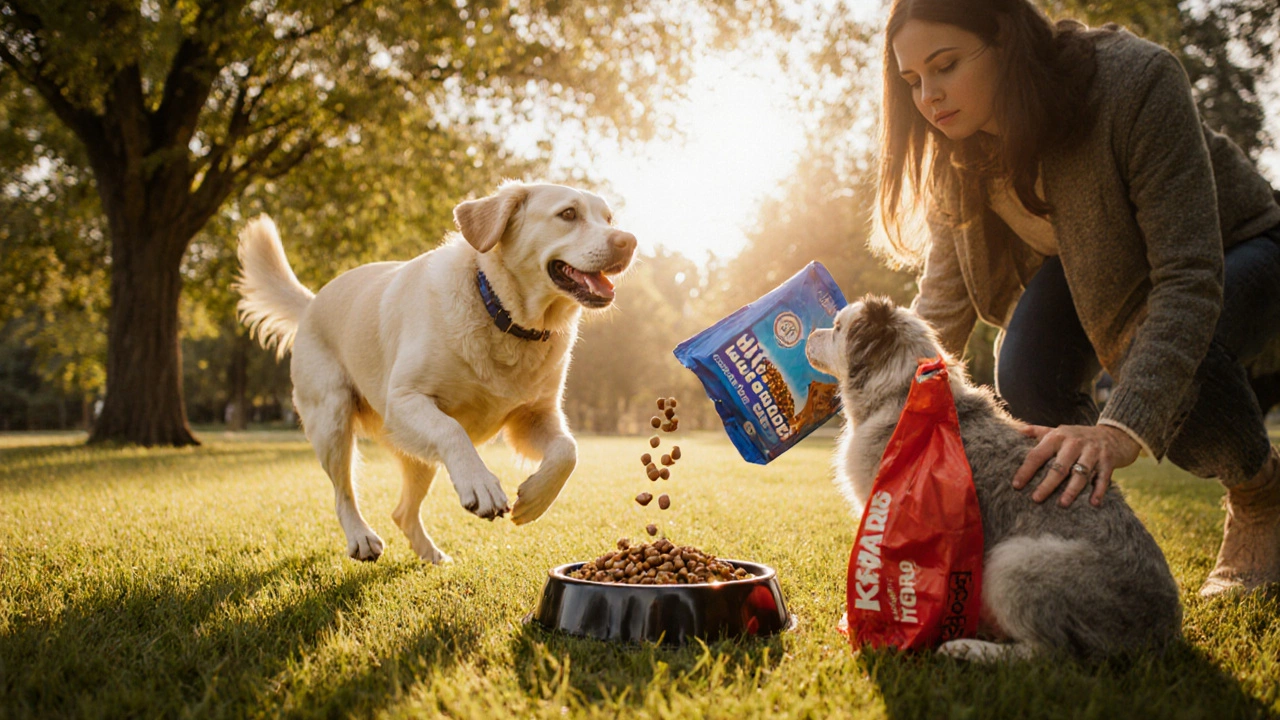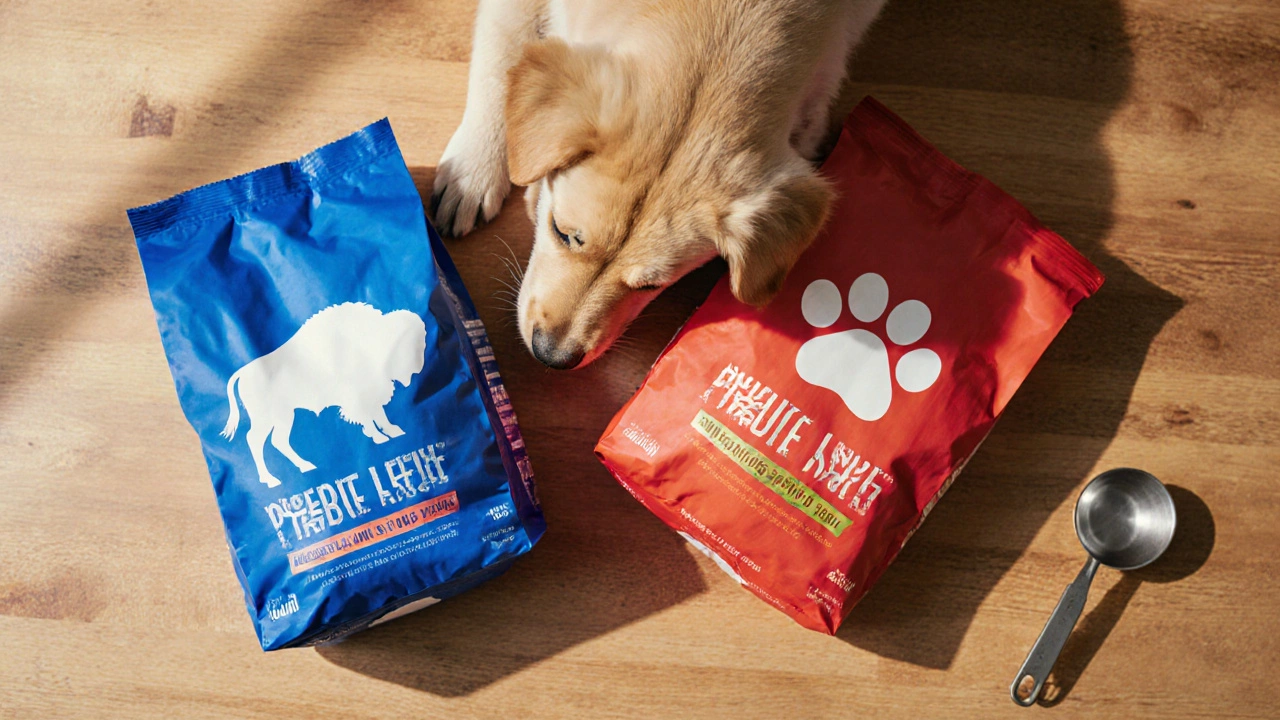Dog Food Comparison Score Calculator
Blue Buffalo
Premium brand focusing on real meat and grain-free options.
Purina
Veterinary-backed formulas with a broad price range.
Rate Each Criterion (1-5)
Comparison Results
Blue Buffalo
Purina
Detailed Criteria Breakdown
| Criteria | Blue Buffalo | Purina |
|---|---|---|
| Ingredient Quality | - | - |
| Protein Content | - | - |
| Grain-Free Options | - | - |
| Price Per Pound | - | - |
| Recall History | - | - |
| Life-Stage Coverage | - | - |
Choosing the right food for your canine companion feels a bit like picking a grocery store aisle - you want quality, you want value, and you definitely want something that keeps them healthy and happy. Two big names dominate the shelves: Blue Buffalo is a premium‑priced brand that markets itself as "real meat" focused, while Purina offers a broader price range and a legacy of veterinary‑backed formulas. Below is the full rundown so you can decide which fits your pup’s needs.
Key Takeaways
- If you prioritize ingredient transparency and grain‑free options, Blue Buffalo usually edges out Purina.
- For large families or multiple dogs, Purina’s lower price per pound can stretch a budget further.
- Both brands meet AAFCO standards, but Blue Buffalo tends to have higher protein percentages.
- Watch for recall histories - Purina had a few high‑profile recalls in the past decade, while Blue Buffalo’s were fewer and less severe.
- Ultimately, the "best dog food" label depends on your dog’s age, activity level, and any sensitivities.
How We Compare Dog Foods
To keep the comparison fair, we score each brand across six criteria that matter most to dog owners in 2025:
- Ingredient quality - source of protein, presence of artificial additives, and ingredient list clarity.
- Protein content - % of crude protein from real animal sources.
- Grain‑free / grain‑included options - catering to dogs with grain sensitivities.
- Price per pound - average retail cost for a 30‑lb bag (USD).
- Recall record - number and severity of product recalls in the past five years.
- Variety & life‑stage coverage - availability for puppies, adults, seniors, and special‑needs formulas.
Each criterion receives a score from 1 to 5; the total points give a quick snapshot of overall performance.
Blue Buffalo Overview
Blue Buffalo launched in 2002 with a promise to use "real meat first" and avoid poultry by‑product meals. Its product lines include Life Protection (grain‑free), Freedom (grain‑free, limited‑ingredient), and Wilderness (high‑protein, grain‑free). The brand proudly lists whole fruits, vegetables, and antioxidant blends like LifeSource Bits.
Protein: Most dry formulas sit between 24‑30% crude protein, sourced from deboned chicken, turkey, or fish. Protein comes from animal tissue, not plant isolates.
Grain‑free options: Approximately 70% of Blue Buffalo’s range is grain‑free, using peas, sweet potatoes, or chickpeas as carbohydrate sources.
Price: A 30‑lb bag averages $55‑$68, translating to $1.80‑$2.30 per pound.
Recalls: Two minor recalls (2018, 2021) involved packaging mislabels; no health‑impact incidents reported.
Life‑stage coverage: Full suite - puppy, adult, senior, and therapeutic formulas for weight management, joint health, and sensitive stomachs.

Purina Overview
Purina is a household name with a portfolio ranging from budget‑friendly Purina Dog Chow to premium Purina Beyond and veterinary‑grade Purina Pro Plan. The company emphasizes science‑backed nutrition, often collaborating with veterinary nutritionists to formulate its lines.
Protein: Pro Plan formulas usually hit 22‑28% crude protein, while the Beyond line stretches to 30% using real meat and fish.
Grain‑free options: About 40% of Purina’s catalog is grain‑free, with the rest featuring whole grains like brown rice and barley.
Price: A 30‑lb bag costs $38‑$62, roughly $1.30‑$2.10 per pound, making it one of the more affordable options for high‑protein diets.
Recalls: Five recalls since 2017, mostly due to contamination or mislabeling; most were handled quickly with limited distribution impact.
Life‑stage coverage: Extensive - includes puppy, adult, senior, and specialty lines for digestive health, skin & coat, and weight control.
Side‑by‑Side Comparison
| Criteria | Blue Buffalo | Purina |
|---|---|---|
| Average protein % | 26‑30 | 22‑30 |
| Grain‑free range | ~70% | ~40% |
| Price per pound (USD) | $1.80‑$2.30 | $1.30‑$2.10 |
| Recall incidents (last 5yrs) | 2 (minor) | 5 (mixed) |
| Life‑stage formulas | All stages + therapeutic | All stages + therapeutic |
| Key differentiator | Ingredient transparency, grain‑free focus | Science‑backed, broader price spectrum |
Pros and Cons
Blue Buffalo
- Pros: Real meat first, high protein, many grain‑free recipes, clear labeling of antioxidants.
- Cons: Higher cost, limited availability of some specialty blends in certain regions, occasional texture complaints from picky eaters.
Purina
- Pros: More budget‑friendly, wide distribution, strong R&D backing, extensive life‑stage options.
- Cons: More use of fillers like corn gluten, fewer grain‑free choices, recall history slightly higher.

Which Dog Benefits Most?
Think about your dog’s specific profile:
- Active, high‑energy adult - Both brands work, but Blue Buffalo’s higher protein and grain‑free formulas may support stamina better.
- Senior with joint concerns - Purina’s Pro Plan Joint Health includes glucosamine; Blue Buffalo’s LifeSource Bits also help but at a higher price.
- Dog with grain sensitivities - Blue Buffalo shines with a larger grain‑free lineup.
- Large household, multiple dogs - Purina’s lower cost per pound helps keep the budget in check.
Final Recommendation
If ingredient purity and grain‑free options top your list, Blue Buffalo is the closer match to the "best dog food" label, despite the higher price tag. If you need a reliable, science‑backed formula that won’t break the bank, especially for a mixed‑age pack, Purina offers solid nutrition with more wallet‑friendly pricing.
Frequently Asked Questions
Is grain‑free always better for dogs?
Grain‑free diets help dogs with specific grain allergies, but they aren’t automatically superior for all pets. Many dogs thrive on high‑quality grains that provide fiber and nutrients. Consult your vet if you notice digestive issues.
How do I transition from Purina to Blue Buffalo?
Mix 25% new food with 75% current food for 2‑3 days, then 50/50 for another 2‑3 days, and finally 75% new/25% old before going 100% new. Observe stool consistency and energy levels.
Which brand has the most therapeutic formulas?
Both offer therapeutic lines, but Purina’s Pro Plan suite is larger, covering weight control, dental health, and skin & coat. Blue Buffalo’s therapeutic range is smaller but focuses on grain‑free, limited‑ingredient diets.
Are there any dog breeds that should avoid Blue Buffalo?
Large, deep‑chested breeds with a tendency toward bloat may benefit from a kibble that swells less. Blue Buffalo’s high‑protein, grain‑free kibble can be denser, so monitor portion size.
How do I store leftover dog food to keep it fresh?
Keep dry kibble in a sealed, airtight container away from direct sunlight. For wet food, refrigerate opened cans within 24‑48hours and discard if it smells off.

